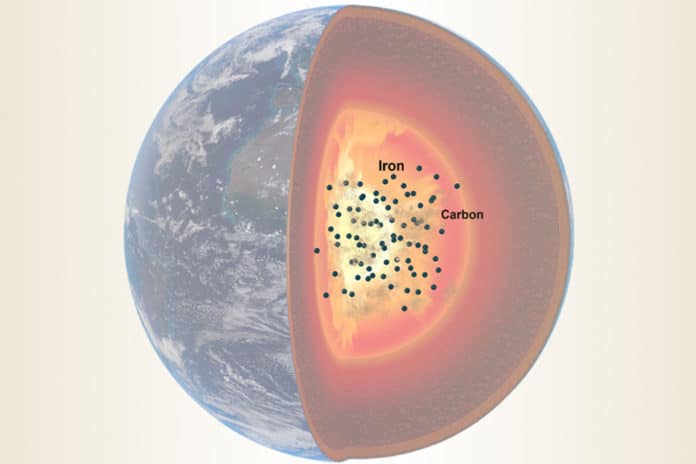A new study has offered a better estimate of the amount of carbon in the Earth’s outer core. It suggested that 0.3 to 2.0 percent of the Earth’s outer core is carbon.
Earth’s core is mainly iron but contains some proportion of lighter elements as well. However, the identity and proportion of the light elements are primarily unknown. Carbon is one of the critical potential light-element candidates in the Earth’s core because of its chemical affinity to the metallic phase and its cosmochemical abundance.
Evaluating carbon’s candidacy as a light element in the Earth’s core is critical to constrain this life-essential element’s budget and planet-scale distribution.
The study by the Florida State University and Rice University used indirect methods to estimate it. They compared the available speed of compressional sound waves traveling through the Earth to computer models that simulated different compositions of iron, carbon, and other light elements at the pressure and temperature conditions of the Earth’s outer core.
Though the percentage of carbon there is low, it’s still an enormous amount because the outer core is so large. Scientists estimated that the outer core contains between 5.5 and 36.8 × 10^24 grams of carbon — an immense number.
Lead author and postdoctoral researcher Suraj Bajgain said, “When the velocity of the sound waves in our simulations matched the observed velocity of sound waves traveling through the Earth, we knew the simulations were matching the actual chemical composition of the outer core.”
Study co-author Rajdeep Dasgupta, the Maurice Ewing Professor of Earth, Environmental and Planetary Sciences at Rice University, said, “There have been a lot of activities over the last decade to determine the carbon budget of the Earth’s core using cosmochemical and geochemical models.”
“However, it remained an open question because of many uncertain parameters on the accretion process and the building blocks of rocky planets. What is neat about this study is that it provides a direct estimate of the Earth’s outer core’s present-day carbon budget. Therefore, this will, in turn, help the community bracket the possible planetary ingredients and the early processes better.”
Journal Reference:
- Suraj K. Bajgain, Mainak Mookherjee, Rajdeep Dasgupta. Earth’s core could be the largest terrestrial carbon reservoir. Communications Earth & Environment, 2021; 2 (1) DOI: 10.1038/s43247-021-00222-7
